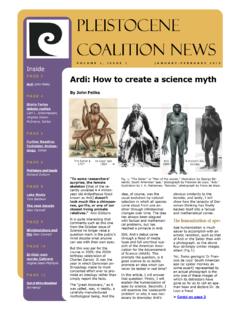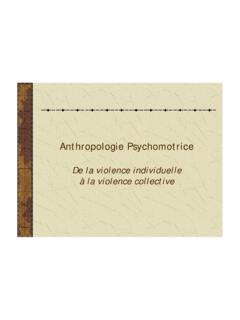Transcription of Pleistocene Coalition News (Oct 2009)
1 Nothing new under the sun." The Pleistocene Coalition chooses to remain open to what the evidence itself is actually telling us which speaks both to change and continuity. We adopt this approach in light of the fact that our entire ability to even con-sider such things is possi-ble only because our spe-cies, homo sapiens, along with its richness and vari-ety of long-lasting world cultures has experienced continuity as well as change through time. Without this sense of con-tinuity to temper our inter-pretations of the evidence, we too would be forced to interpret our early ancestors in the lesser terms of popu-lar science even so far as to regard them as half-way- Contd on page 2 Archaeology is usually defined as the study of the human past.
2 It is a scientific field that at-tempts to learn as much as possible about our an-cestors and the great variety of human ex-perience from remains in what is known as the archaeological record. Yet in recent years the focus in the branch of ar-chaeology related to early peoples, sometimes re-ferred to as palaeoanthro-pology, is almost entirely driven by the single con-cept of expected change over time. The focus on change has been so prevalent that many have forgotten the equally important and valid concept of stability or continuity through time. So one of the goals of the Pleistocene Coalition is to address this almost forgot-ten realm.
3 We intend to draw attention away from our differences and more toward the similarities that we share with our ancestors. We commonly hear such things today as, "Nothing stays the same except for change." While this is a popular and clever saying, it is certainly not true in and of itself. There is as much evi-dence in archaeology that is as well described by the op-posite expression, "There is It has been very difficult to bring to public attention the scientific data for the ancient archaeological sites from the Valsequillo area of east cen-tral Mexico. I equate it with an attempt to crawl up a particularly steep rocky hill-side tied up in a sleeping bag.
4 The latest hurdle is my new website. In the changeover, critical data have disap-peared from the site proper, and the forum section does-n't even recognize my name. This has been going on for many weeks. The main problem started in 1968 with geochemist Barney Szabo's uranium-series dates on a mastodon tooth fragment from El Horno and a fragment of butchered camel bone from Hueyatlaco. Both specimens were associated with well made (but differently crafted) stone tools. We were expecting dates of ca 20,000 years. No 14C dates were possible because no Contd on page 2 Continuity through time By John Feliks The long haul Virginia Steen-McIntyre on the fight for recognition at Valsequillo BUSINESS NA MEBUSINESS NA MEBUSINESS NA MEBUSINESS NA ME Pleistocene Coalition NEWS O C T O B E R 2 0 0 9 V O L U M E 1 , I S S U E 1 Inside PAGE 2 Mystery of the Doren-berg Skull PAGE 3 Deep roots of aesthetic de-sign Suggested reading PAGE 4 Anomalies palaeo-smarts 350.
5 000 years ago Relaunch of The First American website PAGE 5 How to join us P A G E 2 The site archaeologist was so appalled she would only allow the dates to be published in a journal few archaeologists would ever ..the ability to think and ponder, to observe .. The long haul (contd.) The mystery of the Dorenberg skull by Patrick Lyons Continuity through time (contd.) there links in an evolution-ary chain. On the side of continuity; human emo-tions and aspirations, the ability to think and ponder, to observe and interact with the animals, the trees, the mountains, the lakes and rivers, the sun, moon and stars, to experi-ence a sense of awe and mystery, to be inspired or to be creative, to ask questions about purpose and meaning, or to other-wise objectively reflect on the wonders or the chal-lenges of the everyday reality around us; these are all things that tran-scend the concept of change.
6 Yet, due to the strong and powerful influence of Charles Darwin, such core human qualities are sug-gested to have come about "of necessity" by gradual means. And so, as we explore fur-ther and further back into time these human qualities must, for the sake of the paradigm, become less and less present in the archaeological record. But we will be providing empirical evidence from many scientific fields, in-cluding engineering and mathematics, that the exact opposite is true. We also won't be afraid to look anew at anomalies, being aware that prior scientific explanations for them, including labeling many such as frauds, have been presented to the public exclusively from the same paradigm of constant change over time.
7 We hope that you enjoy this first issue of our Newsletter and that you return again to learn more about our early human heritage. It is our prehistory. It is our story. publication was delayed, letters unanswered -- 1976, 1977, 1978 .. Finally ~ word came that they decided not to publish the proceedings volume at all. Another editor asked to see it, and it was sent off. Delays. No answers to letters. A phone call cornered the man who, after some stut-tering, said that the manu-script had fallen down behind the file cabinet and had been lost. In 1981 our research was finally published in a pres-tigious journal for Quater-nary (Ice Age) scientists (Steen-McIntyre et al.)
8 , 1981, Quaternary Re-search, v. 16, pp. 1-17.) These type of problems have been going on for forty years! For the whole shabby story up until 2006, read Chris Har-daker's The First Ameri-can and visit his website. datable carbon re-mained. Instead, Barney gave us dates of 250,000 - 350,000 years! The site archaeologist was so ap-palled she would only allow the dates to be published in a journal few archaeolo-gists would ever read.(Szabo et al., 1969, Earth and Planetary Science Let-ters, v. 6, pp. 237-244.) So it began. The next geological paper to confirm these old dates was sub-mitted in 1975. But the Codex (Dorenberg) Colombino Photo courtesy of Jens S.
9 Ro-hark Bartusch, 2008 P L E I S T O C E N E C O A L I T I O N N E W S In the 1890s, an ancient skull was found in the foun-dation of a house in Puebla, Mexico. This is the story of that skull, the people behind its discovery, and what the skull means to para-digms that hold back American archaeology. Joseph Dorenberg, a wealthy German mer-chant living in Puebla at the time of its discovery acquired the skull that now bears his name as part of an ongoing effort to collect antiquities in the region. The skull was female, missing its lower jaw and had a bony out-growth from the root of a tooth. Dorenberg showed great interest in the antiquities of Mexico and became a well-known collector of rare pre-Columbian arti-facts from the region.
10 He acquired what was then known as the Dorenberg Codex , one of only a handful of Mixtec books in existence, now a priceless treasure. go to page 3 P A G E 3 ..modern humans share a hardwired template with our ancestors as far back as homo Eduard Seler in his study Photo courtesy of Ibero-Americanisches Institut, Walter Lehmann and Walter Krickenberg, 1927 Suggested reading .. Dorenberg Skull (contd.) He enlisted the assistance of Eduard Seler, a famous German ethnologist, to document the codex through the production of colored prints. The codex was sold in to the Museo Nacional de Antropolog a in Mexico City to be put on display in 1892.













